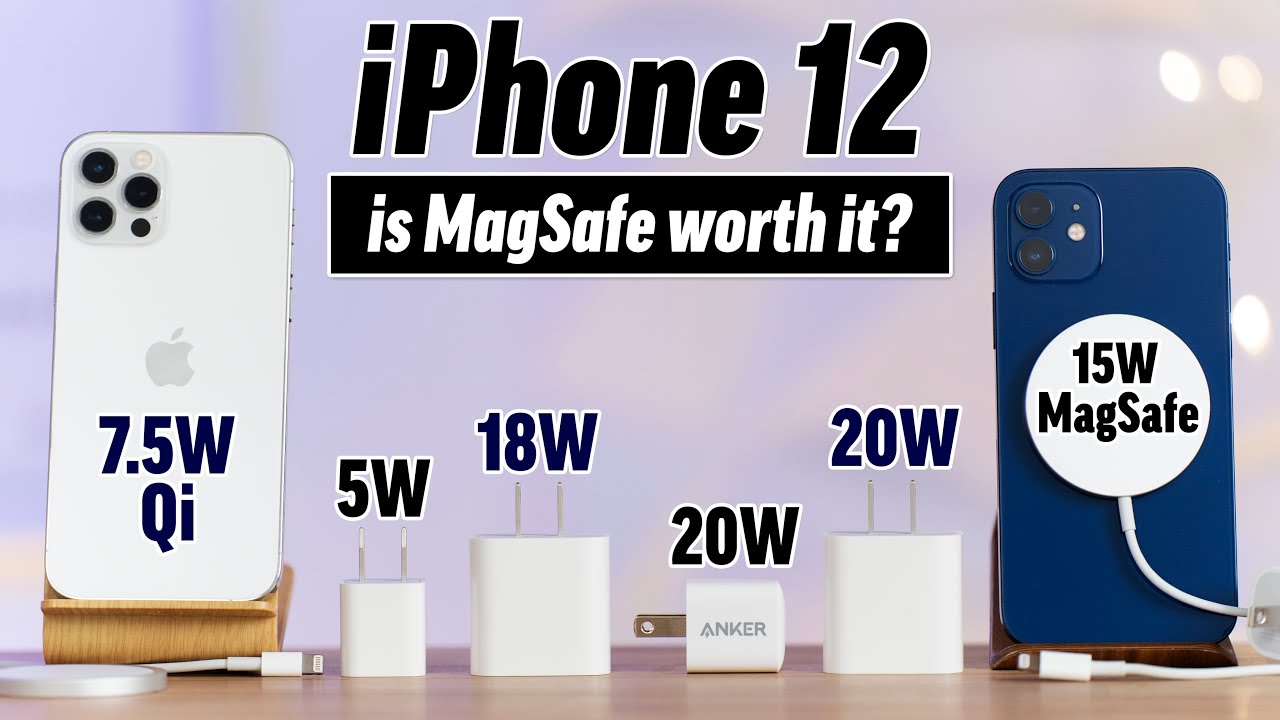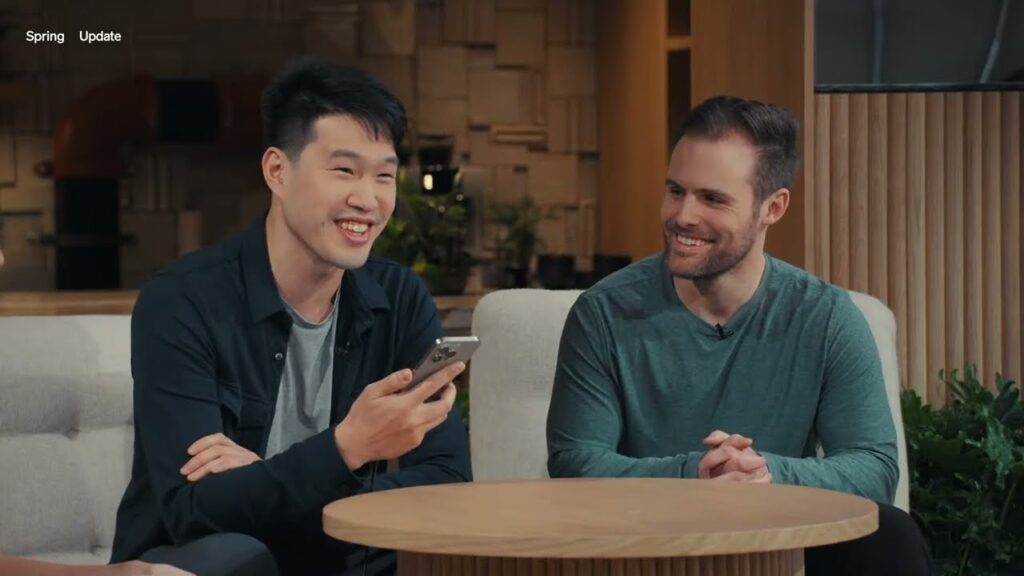In this video Im going to answer 3 things, first how still faster is Magsafe charging than standard 7.5 W Qi wireless blame? Second, is magsafe blame much slower than using a lightning cable, spoiler alerting, yeah itis .. And third, do “youve been” have to buy Apple’snew 20 W usb-c charging brick or can you use an older 18 W one you might have, and if youdon’t, how about a cheaper and much smaller third party charger like the 20 W Anker Nano? Which btw I adore and have attached down in the video description below. I likewise share 3 very weird things I determined whenusing my wattage rhythm with these chargers that I havent heard anyone truly mention. Let’s is the beginning by comparing 4 standard chargersso it’s easy to see significant differences before we throw in the towel some variables. We have the 5wattlighting that everyone has, a cheap 7.5 W qi wireless charger that is super convenientand too linked below, Apple’s Magsafe charger with the brand-new 20 W brick, and 20 W fast lightningcable charging.After 10 min of blaming the 5W got us toan 8% charge, 7.5 W Qi actually blamed 1% little at 7 %, Magsafe amazingly resultedin only 3% more at 10% and 20 W lightning gave us a whopping 20% charge in really 10 min. To be honest I was expecting 15 Watts of magsafeto be about twice as fast as 7.5 W Qi charging instead of only 30% faster, and only 2 percentagepoints greater than gradual 5W accusing, but perhaps it will accelerate as we go on. 20 min in, 5W cabled gained 6% charge, regularwireless accusing gained 5 %, and thankfully magsafe bided consistent with the first 10 minand gained another 10% accuse. 20 W lightning too abode coherent and gained another2 0% for a total of 40% charge in exactly 20 min. This is where the first funny thing showedup when I exercised my wattage rhythm to measure out Apple’s brand-new fast blaming brick that’s ratedat 20 W. As soon as I plugged in the rhythm instead of showing 20 W being drawn it consistentlyshowed ..( AD) 18 Watts. I measured this multiple times with differentcables and iPhones and the result was the same. More on this, and what it entails in justa bit but first let’s get back to the blaming hurrying comparing. 30 min into the test we have 20% bill for5W cabled, 18% for regular wireless accusing, 30% for Magsafe, so hey were finally seeinga good divergence with this faster wireless accusing, and 58% use fast lightning charging.So as you ensure, even without the full 20 W fromthe brand-new charger, Apple still outperformed its advertised 50% in 30 min. Tells jump to the 40 min Mark where the slowchargers are maintaining a consistent pace but the fast chargers are starting to slowdown. Our 7.5 W wireless charger is still 3% behind the gradual 5W wired charger which isreally sad, and magsafe 16% higher at 38%, but that’s still 34% behind fast lightningcharging at 72%. And here’s the scores after 50 min, as youcan see 5W cabled and 7.5 W wireless blaming are staying super consistent so far at about6% bill per 10 min, Magsafe slowed down after its good start to about 8% per 10 min, and wired really slowing down now gaining really 9 %. Now for that nice round 1 hour tag. 5W wiredis at a sad 39%, 7.5 Wireless an even bad 36%, Magsafe with 20 W brick at 55% and 20 Wwireless at 88% which is enough juice for a whole day for numerous beings. As you can seeMagsafe made twice as long to charge to 50% compared to fast lightning blaming. To speed up the test Im going to jump to15min increments now but first causes quickly touch on that 20 W fast lightning charging.As you can see it started slowing down after the first 30 min and really slowed down afterwe touched 80% gaining merely 7 percent between 50 and 60 min instead of 20 percentage each 10 minat the start. I was curious how much the wattage tapersdown with the chargers as the phones become more accused so I tested them. The 5W lightningand 7.5 W wireless dont taper down at all, magsafe does slow down a bit, but fast lightingtapers like crazy. It starts out with 18 W fast billing if youreusing a 12 or 12 Pro, by the way my 11 Pro Max accepts the full 20 W from this charger, and the 12 s maintain attracting 18 Watts until the phone slams 50% at which point they slowdown to 14 W.That lasts until 70% where it then slows down to 9 Watt charging but thatonly lasts until 80% indictment, where we have another slow down to exactly 5w accusing forthe remaining 20%. Let’s get back to the charge test and finishit up. Going from 1 hour to 1:15 the 5watt mounted by 9 excellent to 48%, 7.5 wireless jumpedby 8 percent, Magasafe increased by 11 excellent and fast lightning by time four percent. After an hour and a half the sluggish chargersfinally reached over 50% and Magsafe hit 75% indict, while USB-C PD was slow blame to96 %. After another 15 min USB-C charging was finished while the others are trying to catchup.At the 2 hour line, our 5W lightning chargerreached 74%, and 7.5 W Qi charging was 6% behind at 68% and magsafe contacted 90% where it startsto slow down even more. So how much more charge do you get after 2hours with this fancy new $40 magsafe charger and $20 brick compared to your super aged slow5W charger? 16% more, let’s just say I was more than a bit baffled. I likewise want to say that this has been themost accepting video to exam, having to constantly charge and then discharge these telephones ismindnumibly abiding so if you appreciate it please smacked the like button and subscribe ifyou so wishes more videos. And to save time let’s jump-start straight to theend result.Magsafe make 2 hours and 45 min to reach 100%, a entire hour ago than fastlightning accuse, and merely 15 min faster than consuming your old-fashioned 5W blaming brick. Comparing 15 W magsafe accusing to a cheapcharging stand significant differences was exclusively 30 min for a full indict. So how is this possible when Magsafe chargesat 15 wats? Well here’s the thing. It doesnt. Apples says it can hit a heyday of 15 Wattsif you use the 20 W charging brick which is true, but they dont say how long it staysthere.In my assessment Magsafe actually peaked over 16 watts but that’s only at the start, after that it would charge at about 6 watts. Now this could be wrong, but my usb-c testerseems to be accurate based on the other tests and it lignes up with the results. The otherquestion is how is Magsafe charging faster at 6W then standard Qi at 7.5 W, well it couldjust be because of perfect alignment and a more efficient coil.The next question I had is if Magsafe spendsmost of its time blame well below 15 watts, do “weve been” need that brand-new 20 W charging brickor can we just use the 18 w older one, or maybe a third party one. Ive seen a few experiments show that other bricksdont smacked the full wattage, but nothing of them tested Ankers new 20 W nano which unlikemost, supports the brand-new PD protocol. After the first 10 min, Apples 20 W with magsafeis just one percent above the other two chargers. When checking the wattage it seems like theAnker needs more time to reach the full 16 W compared to Apples but once it does it actuallystays there a bit longer, as you can see by the 20 min target, Ankers brick is slightlyahead compared to the others. 30 min in, Apple’s older 18 W power adapteris just one per cent behind the 20 W, and Ankers is 2% ahead. The divergence goes somewhat wider after 40 min withAnkers now being 5% ahead of Apples 20 W and 6% above the 18 W charger, and after 50 Minit reaches above 50%, a consistent 10 percent every 10 min compared to 8 percent for Apples2 0Watt and 7 for the 18 W.This trend continues so lets climb to 1 hourand 30 min where Apples advertised pairing is at 75%, the 18 W brick is only 2% behindat 73%, and Anker achieves 83%. How is this possible if the Anker is ratedfor the same 20 W, well first off, its not tapering down its wattage as fast and whenit does its actually proceeding 6.5 W where apples chargers are plucking 6 watts. Tells jump to 2 hours now, where charging speedsare really slowing down and Apples bricks are at 89 and 90% while Ankers is at 95%. 15 min later the Anker is done taking a total time of 2 hour and 15 min. Apples chargers take much longer to finishoff the last little bit, their 20 W brick takes 30 min longer than Ankers at 2 hours and 45 min, and their 18 W brick takes an additional 15 min for a total epoch of three hour, the sameexact time as sluggish 5W lightning charge. So we have our final results. 15 watt Magsafecharging is road slower than we thought. Sure if you want to top off a low-toned battery it’sa little faster than your 5watt brick but you’re style better off applying a lightning cable, it’s literally twice as fast.With that said, if you have an 18 W chargingbrick dont bother buying the 20 W to lightning freight your iPhone 12 or 12 Pro since theyseem to be limited to 18 watts. Im guessing only the Pro Max will use the full 20 wattto allow it to reach 50% in 30 min. For those of you wanting to use magsafe youmight as well use an 18 W usb-c brick if you have one because the charging hurried is barelydifferent, but if you dont or you want the fastest magsafe accuse buy an AnkerNano. It’s very small and continues its wattage slightly higher and longer than Apples, Illlink it down in the video description.No this video is not sponsored by Anker, butI am trying to work out a deal with them since I previously its utilization and love their small-scale usb-c chargers. And as a last-place indicate, if youre going to buyan iPhone 12 mini, that wont accept the full 15 or 16 W heyday of Magsafe, Apple is sayingits limited to 12 W. Let me know your thoughts down below and ifyou want to support our path pick up a super soft max tech fee shirt, hoodie, or mask in that merch shelf or by exerting our tie below.If you want to see how fast Magsafe chargesother iPhones or Androids I have a very interesting video right over there, and why not subscribeif you havent already for more videos like this one which almost no one is manufacturing. Thanks for watching this has been Max andIll see you in the next video ..





